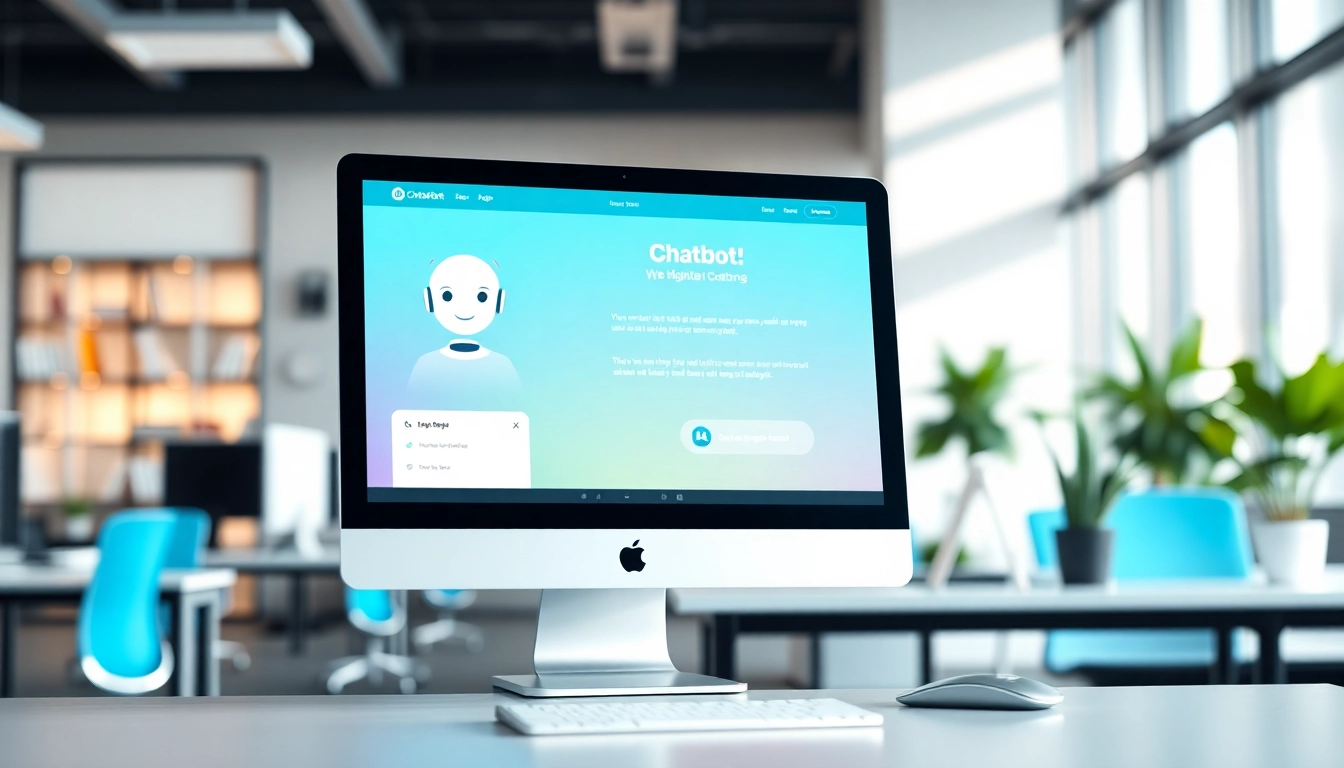Understanding Website Chatbots
What is a Website Chatbot?
A website chatbot is an artificial intelligence program designed to simulate conversation with human users, primarily over the Internet. A chatbot operates on a predetermined script or employs advanced algorithms like machine learning and natural language processing to engage users in a conversational manner. These digital assistants can handle inquiries, provide information, and facilitate user interactions 24/7, serving various purposes in customer service, lead generation, and user engagement. Unlike traditional customer service channels, a website chatbot can analyze and interpret user requests, respond instantly, and even learn from previous interactions to improve its responses over time.
The Benefits of Implementing a Chatbot
Deploying a chatbot on your website comes with several advantages. Here are some key benefits:
- Improved User Engagement: Chatbots provide instant responses to user inquiries, ensuring higher engagement rates as users receive timely information without waiting for human intervention.
- Cost Efficiency: Automating routine inquiries allows businesses to reduce customer service staffing costs while optimizing resource allocation to more complex issues.
- Availability: Chatbots operate 24/7, providing a continuous engagement channel. This ensures that users can have their questions answered regardless of time zones or traditional business hours.
- Data Collection: Chatbots can collect valuable user data, enabling businesses to refine marketing strategies and improve product offerings.
- Personalized User Experience: A well-designed chatbot can tailor interactions based on user behavior and preferences, leading to a more personalized experience that fosters brand loyalty.
Types of Chatbots Available
There are various types of chatbots, each serving different purposes and utilizing unique technologies. Here are the primary categories:
- Rule-Based Chatbots: These chatbots follow a scripted flow, providing responses based on specific keywords and set commands. They are effective for straightforward FAQs but can struggle with more complex inquiries.
- AI-Powered Chatbots: These utilize natural language processing (NLP) and machine learning to understand user input better, allowing for more dynamic and natural conversations. They can learn from interactions to enhance their responses over time.
- Hybrid Chatbots: Combining both rule-based and AI-powered designs, hybrid chatbots can efficiently handle simple queries while escalating complex issues to human agents as needed.
- Social Media Chatbots: These bots integrate within social media platforms, providing seamless customer interactions across channels like Facebook Messenger or WhatsApp.
Key Features of Successful Chatbots
Natural Language Processing in Chatbots
Natural Language Processing (NLP) is a critical component that enables chatbots to understand and interpret human language effectively. Through NLP, chatbots can parse user queries, identify intent, and respond in a way that mimics human conversation. This capability enhances user experience by allowing for more intuitive interactions. Implementing advanced NLP techniques helps in the following ways:
- Understanding Context: By analyzing context, chatbots can provide accurate responses to ambiguous messages, making them feel more natural and human-like.
- Sentiment Analysis: Modern chatbots can gauge the emotional tone of user communications, enabling them to tailor responses accordingly. This sensitivity can help in defusing tense situations or escalating issues appropriately.
- Multi-Language Capabilities: NLP enables chatbots to converse in multiple languages, allowing businesses to cater to a diverse customer base without language barriers.
Integration with Existing Systems
A successful chatbot must seamlessly integrate with existing systems like Customer Relationship Management (CRM), Content Management Systems (CMS), and e-commerce platforms. This integration ensures that the chatbot can provide up-to-date information, manage user accounts, process transactions, and track inquiries. By connecting the chatbot with various systems, businesses can:
- Enhance Personalization: Access to user data allows chatbots to deliver tailored responses and recommendations based on prior interactions.
- Streamline Processes: Integration facilitates automated workflows, reducing the need for manual input by customer service representatives and increasing efficiency.
- Analyze Performance: Integrated chatbots can offer insights into user behaviors and trends, allowing organizations to refine their strategies over time.
User-Friendly Interface Design
The design and interface of a chatbot play a vital role in its effectiveness. A user-friendly interface encourages engagement and simplifies interactions. Here are key elements to consider:
- Intuitive Navigation: Users should be able to navigate the chatbot easily, with clear prompts and instructions guiding them on how to proceed.
- Visual Elements: Incorporating visual elements like emojis, buttons, and quick replies can make interactions more engaging and reduce user effort.
- Mobile Responsiveness: Given the shift towards mobile browsing, chatbots must be optimized for mobile devices, ensuring that they function seamlessly on both phones and tablets.
- Accessibility: Ensure the chatbot is usable for individuals with disabilities. Compliance with accessibility guidelines can widen the audience and improve overall satisfaction.
Developing a Chatbot Strategy
Identifying User Needs and Goals
Before launching a chatbot, businesses must identify user needs and clearly define the bot’s objectives. This phase involves extensive research and interaction mapping to determine common user queries, pain points, and desired outcomes. Possible steps include:
- Surveying Users: Collect user feedback through surveys and interviews to understand their expectations from the chatbot.
- Analyzing Current Interactions: Review existing communication channels to pinpoint frequently asked questions and issues.
- Defining Success Metrics: Establish what success looks like for your chatbot, such as user satisfaction levels, response accuracy, or lead conversion rates.
Choosing the Right Technology Stack
Selecting the appropriate technology stack is critical in developing an effective chatbot. Factors to consider include:
- Development Platforms: Choose platforms that suit your technical expertise and budget. Some popular ones include Dialogflow, Microsoft Bot Framework, and Amazon Lex.
- Hosting Considerations: Decide whether to host the chatbot on the cloud, on-premises, or use a hybrid approach. Each option comes with its pros and cons regarding scalability, security, and maintenance.
- Integration Capabilities: Make sure that the selected tools can easily integrate with your existing tech stack for seamless functionality.
Setting Performance Metrics
Defining specific performance metrics is essential for evaluating the chatbot’s success and identifying areas for improvement. Key performance indicators (KPIs) might include:
- User Satisfaction Score: Gauge user satisfaction through direct feedback or post-interaction surveys.
- Conversion Rate: Measure how well the chatbot converts leads or performs tasks such as bookings or purchases.
- Response Time: Track the average time taken by the chatbot to respond to user inquiries.
- Fallback Rate: Monitor how often the bot fails to understand user inquiries and escalates to a human representative.
Implementing Your Website Chatbot
Steps for Effective Deployment
Once the chatbot strategy has been defined, the next process is implementation. Here’s how to ensure effective deployment:
- Prototype Development: Build a prototype to test functionality and gather early feedback. This step allows for adjustments before the full launch.
- Beta Testing: Release the chatbot to a select group of users to identify any potential issues and gain insights on user interactions.
- Full Launch: Roll out the chatbot to the public, ensuring that support resources are available for users who may encounter challenges.
Training Your Chatbot for Better Performance
Training is a continuous process aimed at improving the chatbot’s capabilities. Key practices include:
- User Interaction Analysis: Regularly analyze user conversations to identify areas where the chatbot may be struggling.
- Regular Updates: Update the knowledge base with new information to ensure that the chatbot provides current and relevant responses.
- Machine Learning Algorithms: Leverage machine learning to adapt the bot’s responses based on user interaction patterns and feedback.
Monitoring and Iteration for Success
Monitoring chatbot performance is crucial for long-term success. Key actions include:
- Performance Analytics: Use analytics tools to monitor interaction data, user satisfaction levels, and conversion metrics to gauge chatbot performance.
- Iterative Improvements: Based on analytics, continuously refine the chatbot’s script and capabilities to better meet user expectations.
- User Feedback Loops: Encourage user feedback to identify pain points and areas for improvement, ensuring that the chatbot evolves to serve users better.
Case Studies and Examples
Small Business Success Stories
Several small businesses have leveraged chatbots to enhance customer experiences and improve operations. For instance, a local coffee shop integrated a chatbot on their website to handle orders and provide information about daily specials. This implementation significantly reduced wait times and allowed staff to focus on customer service, ultimately increasing customer satisfaction ratings.
Enterprise-Level Chatbot Solutions
Large organizations have also seen immense value from implementing sophisticated chatbot systems. A renowned airline introduced a chatbot capable of managing bookings, checking flight statuses, and resolving customer queries. This initiative led to a notable reduction in call center volumes, allowing the airline to allocate resources more effectively while improving customer engagement across digital channels.
Common Challenges and Solutions
Despite the benefits, businesses may encounter challenges while implementing chatbots. Common issues include:
- Misunderstanding User Intent: Users may phrase inquiries differently than expected, leading to incorrect responses.
- Data Privacy Concerns: Users may worry about how their data is utilized and secured.
- Limited Functionality: Basic chatbots may fall short in handling complex queries, prompting user frustration.
Potential solutions include investing in advanced NLP technologies, ensuring transparency regarding data use, and committing to iterative development to broaden the chatbot’s functionality over time.



